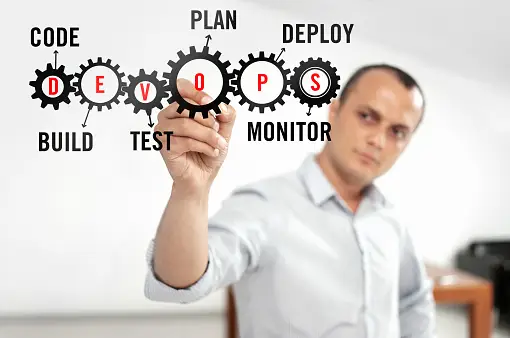Efficiency and speed are key components in the software development industry. It is critical to release features and updates in a timely manner without sacrificing quality. This is where Site Reliability Engineering (SRE) and DevOps become important techniques. They play different but complementary functions in the software development lifecycle, despite their frequent interchangeability.
The complex relationship between SRE and DevOps is explored in this article. We'll go over their guiding ideas, points of convergence and divergence, and how their combined efforts open the door to a software delivery method that is more dependable and efficient.
DevOps: Bridging the Silos
DevOps is a methodological and cultural movement that breaks down the conventional divisions between development and operations teams. It encourages teamwork, automation, and ongoing enhancement over the course of the software lifecycle. Here's a glimpse into the core principles of DevOps:
Shared Responsibility: DevOps dismantles the walls between development and operations, promoting a shared responsibility model. Developers and operations personnel work together to deliver, deploy, and maintain software.
Automation is King: Repetitive tasks across development, testing, deployment, and infrastructure management are automated using tools and scripts. This frees up valuable time for teams to focus on higher-level activities like innovation and problem-solving.
CI/CD Pipeline for Speed: DevOps heavily relies on Continuous Integration and Continuous Delivery (CI/CD) practices. These practices ensure frequent code commits, automated builds and testing, and streamlined deployments, enabling faster release cycles.
Monitoring and Feedback Loop: DevOps emphasizes continuous monitoring of applications and infrastructure to proactively identify and address issues. Feedback loops are established to learn from deployments and continuously improve processes.
SRE: Ensuring Reliability at Scale
SRE is a specialised engineering field that uses the concepts of software engineering to keep production systems scalable and reliable. SRE teams, with a clear emphasis on high availability and performance, bridge the gap between traditional operations and software development:
Metrics-Driven Approach: SRE teams define Service Level Agreements (SLAs) that outline the expected performance and availability of critical systems. They rely heavily on metrics to monitor system health and identify potential issues before they impact users.
Automation for Efficiency: Automation is a cornerstone of SRE practices. Tasks like infrastructure provisioning, configuration management, and incident response are automated using tools and scripts. This allows SREs to manage complex systems efficiently and scale effectively.
Chaos Engineering for Resilience: SREs might utilize chaos engineering practices to deliberately introduce controlled disruptions to identify weaknesses in systems. This proactive approach helps ensure systems can recover gracefully from failures and maintain high availability.
Root Cause Analysis is Key: When incidents occur, SREs focus on identifying the root cause of the problem to prevent future occurrences. They strive to implement solutions that improve system resiliency and prevent regressions.
Areas of Overlap: A Foundation for Success
While DevOps and SRE have distinct areas of focus, they share some core principles that create a strong foundation for success:
Collaboration is Paramount: Both DevOps and SRE emphasize collaboration between teams. DevOps fosters collaboration across development and operations, while SRE teams collaborate with both sides to ensure reliable software delivery.
Automation Fuels Efficiency: Automation is a game-changer in both DevOps and SRE practices. Automating tasks improves efficiency, reduces human error, and enables faster deployments and incident response.
Monitoring and Observability: Gaining insights into system health and performance is crucial for both disciplines. They rely on monitoring tools and metrics to proactively identify and address potential issues.
Areas of Difference: Specialized Expertise
Despite their overlaps, DevOps and SRE have distinct areas of expertise:
Focus: DevOps has a broader focus on the entire software lifecycle, encompassing everything from development to deployment and operations. SRE has a narrower focus, primarily concerned with ensuring the reliability and performance of production systems.
Metrics that Matter: While both use metrics, they prioritize different aspects. DevOps might focus on metrics related to deployment frequency, lead time, and change failure rate. SREs are more concerned with metrics that align with SLAs, such as uptime, latency, and error rates.
Skillset for Success: DevOps engineers typically possess a broader skillset that spans development, testing, and infrastructure management tools. SREs often have a strong background in software engineering and systems administration, with expertise in tools like monitoring, automation, and chaos engineering.
Working Together: A Symbiotic Relationship
While distinct, DevOps and SRE are not mutually exclusive. In fact, their combined efforts lead to a more efficient and reliable software development process. Here's how they work together:
DevOps Sets the Stage: By establishing a culture of collaboration, automation, and continuous improvement, DevOps creates a foundation that enables SRE practices to thrive. Efficient pipelines and focus on quality ensure reliable deployments for SRE teams to manage.
SRE Ensures Stability: SRE practices ensure that the systems built and deployed through the DevOps pipeline are reliable and performant, meeting user expectations. They continuously monitor systems, identify bottlenecks, and implement solutions to maintain high availability and scalability.
Shared Ownership: Both DevOps and SRE teams share ownership of the entire software delivery process. They work together to identify and address bottlenecks, improve deployment pipelines, and ensure a smooth flow from development to production. This shared responsibility fosters a culture of continuous learning and improvement.
The Road to Success: Embracing Collaboration and Shared Goals
By understanding the relationship between DevOps and SRE, organizations can create a more streamlined and efficient software delivery process. Here are some key takeaways to ensure success:
Break Down Silos: Foster a collaborative environment where development, operations, and SRE teams work together towards shared goals. Encourage open communication and knowledge sharing.
Embrace Automation: Leverage automation tools to streamline repetitive tasks across the software delivery pipeline. This frees up time for teams to focus on higher-value activities and innovation.
Metrics-Driven Decisions: Implement a robust monitoring and metrics platform that provides insights into development, deployment, and system performance. Use data to make informed decisions and identify areas for improvement.
Continuous Learning: DevOps and SRE are evolving practices. Encourage continuous learning within teams to stay updated on the latest tools, methodologies, and best practices.
Conclusion: A Symbiotic Relationship for Reliable Software Delivery
SRE and DevOps are two sides of the same coin, not opposing forces. When used well, they establish a mutually beneficial relationship that promotes teamwork, automation, and a dedication to the supply of dependable, high-quality software. Organisations may design a more effective and simplified software development process that provides value to users more quickly and consistently by recognising their unique responsibilities and areas of overlap..







Top comments (0)